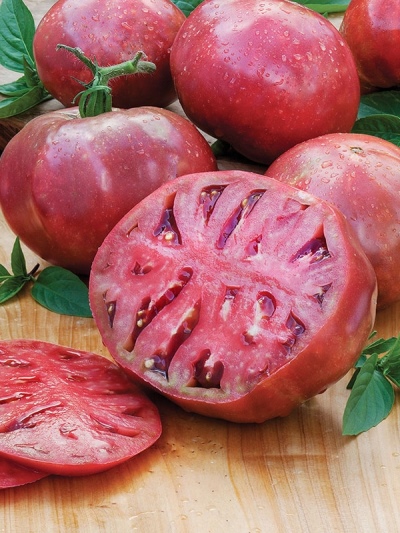
- Authors: USA
- Name synonyms: Cherokee Purple
- Category: grade
- Growth type: semi-determinant
- Appointment: fresh consumption, for juice, for ketchup and tomato paste
- Ripening period: mid-season
- Ripening time, days: 110-115
- Growing conditions: for open ground, for film greenhouses
- Bush size: tall
- Bush height, cm: 180
A spectacular semi-determinant tomato variety, Cherokee Purple was bred in the United States but has been successfully cultivated around the world. It is universal in its application, but fruits are especially good in processing - when preparing juices, ketchups, tomato paste. Cultivation in the Russian climate can be carried out both indoors and outdoors, the variety is highly valued by collectors for its stability in the formation of ovaries, unique taste properties.
Description of the variety
Tall bushes of this tomato variety reach a height of 180 cm. They have thick stems, simple leaves of a traditional green hue. The tops of medium density, reminiscent of a potato. Fruit clusters include 4-5 tomatoes, up to 8 of them are formed on the stem.
The main qualities of the fruit
Beautiful, large tomatoes with a purple-hued skin reach a mass of 300-400 g. Their shape is flat-round, corresponding to the beef category. The pulp of the fruit is burgundy-raspberry, with a green seed gel. The cameras inside are small, but there are many of them.
Taste characteristics
Fruits are tender and sweet, poorly suited for storage. Prone to cracking on branches. Taste nuances are gourmet, with harmonious sour notes, spicy aroma, pronounced, with smoky nuances.
Ripening and fruiting
The Cherokee Purple tomato is considered mid-season. Fruit ripening takes 110-115 days.
Yield
The variety is fruitful.
The timing of planting seedlings and planting in the ground
You can sow seeds in early or mid-March. The seedlings are transferred to the ground not too early, at the end of the return frosts. On average, at the age of 55-60 days.

Growing tomato seedlings is an extremely important process, because it largely depends on whether the gardener will be able to harvest at all. All aspects must be taken into account, from seedbed preparation to planting in the ground.
Landing scheme
The bushes are large, therefore, require a relatively sparse planting. No more than 3 bushes are placed per 1 m2.

Growing and care
It is customary to form bushes of the Cherokee Purple variety into 2-3 stems. In the process of growth, stepchildren should be regularly cut off by hand under the lower flower brush. And also, when transplanting into the ground, props are immediately organized, in the form of trellises or individual stakes. Fastening to a mesh fence with twines or clothespins is practiced.




A plant needs different micronutrients at each stage of growth. All fertilizers can be divided into two groups: mineral and organic. Folk remedies are often used: iodine, yeast, bird droppings, eggshells.
It is important to observe the rate and period of feeding. This also applies to folk remedies and organic fertilizers.
Disease and pest resistance
The Cherokee Purple tomato is resistant to the main diseases of nightshade crops. But he needs protection from pests. Especially carefully it is worth examining the bushes for the detection of a spider mite or whitefly. These pests are difficult to get rid of in the greenhouse, so spraying with insecticides should be started as early as possible.
Among the diseases affecting this variety of tomatoes, one can distinguish fusarium wilting and black leg. The risks of their development are especially high in greenhouses, where the ventilation regime is violated. It is important to carefully regulate the humidity in the air. And it will also be useful 2-3 times during the season to carry out the treatment with fungicidal preparations.


Resistant to adverse weather conditions
Tomato tolerates temperature changes well, grows well in extreme heat and drought conditions. The moisture content of the soil must be regulated to prevent the formation of cracks in the skin of the fruit.
Growing regions
It is recommended to plant in the middle lane and in the north of Russia exclusively in greenhouse conditions. Outdoor cultivation is possible only in the south.
Review overview
Cherokee Purple is a variety well known to American breeders, but for Russia this purple tomato is still exotic. Nevertheless, many summer residents have been successfully planting it for more than 15 years in a row, having no difficulty in obtaining bountiful harvests. Fruiting is stretched out, fresh tomatoes can be harvested until mid-autumn. In the open field, it can be grown even in the middle lane, subject to dry and hot summers.
Amateur vegetable growers speak highly of the taste of Cherokee Purple tomatoes. It is recommended to use it when creating sandwiches and sandwiches, add it to salads and preparations that do not require whole-fruit preservation. The main disadvantage of the variety is the poor keeping quality of the fruits. They easily wrinkle after being plucked from the bush, and are not intended for long-term storage.

























































































